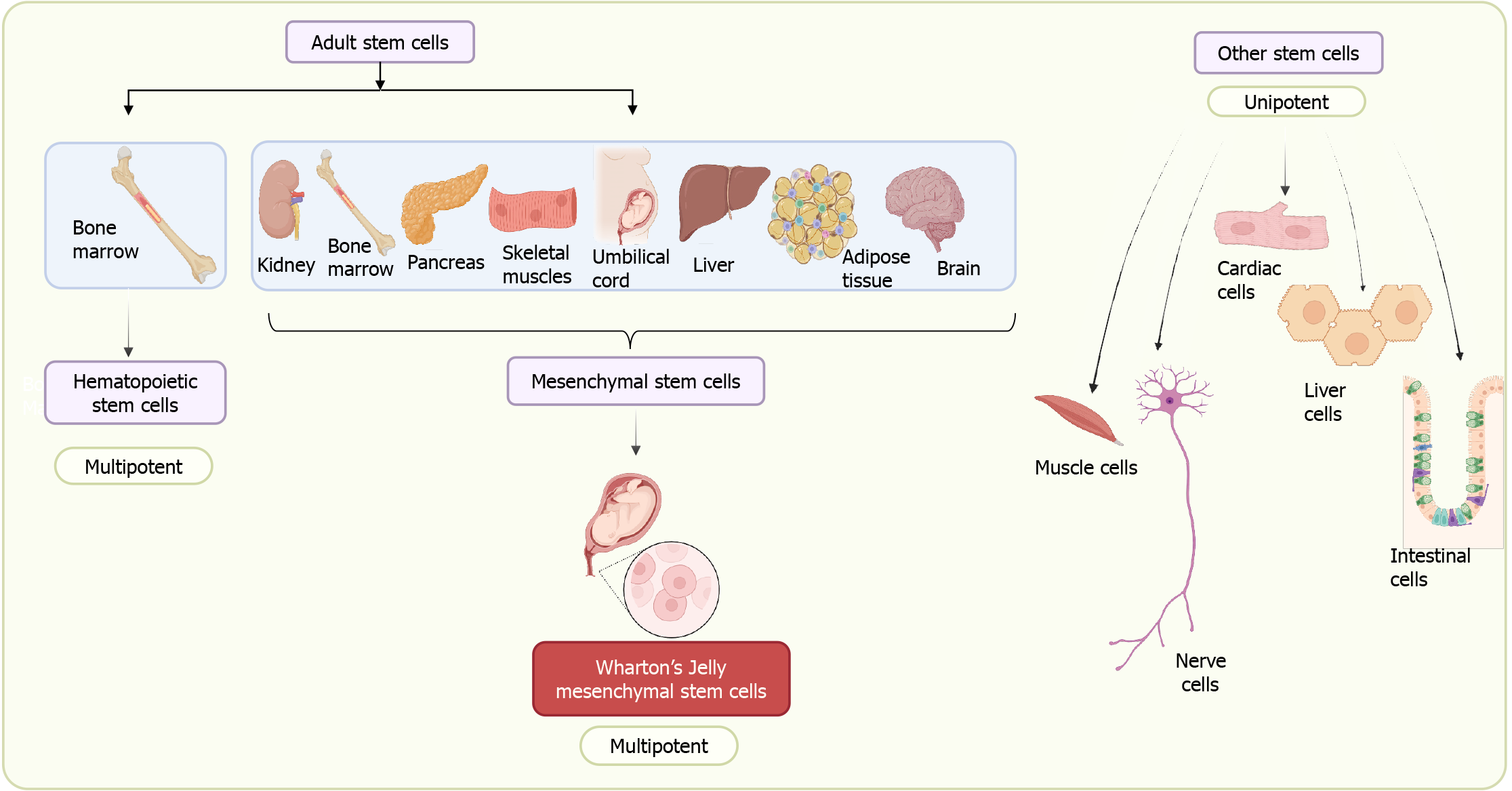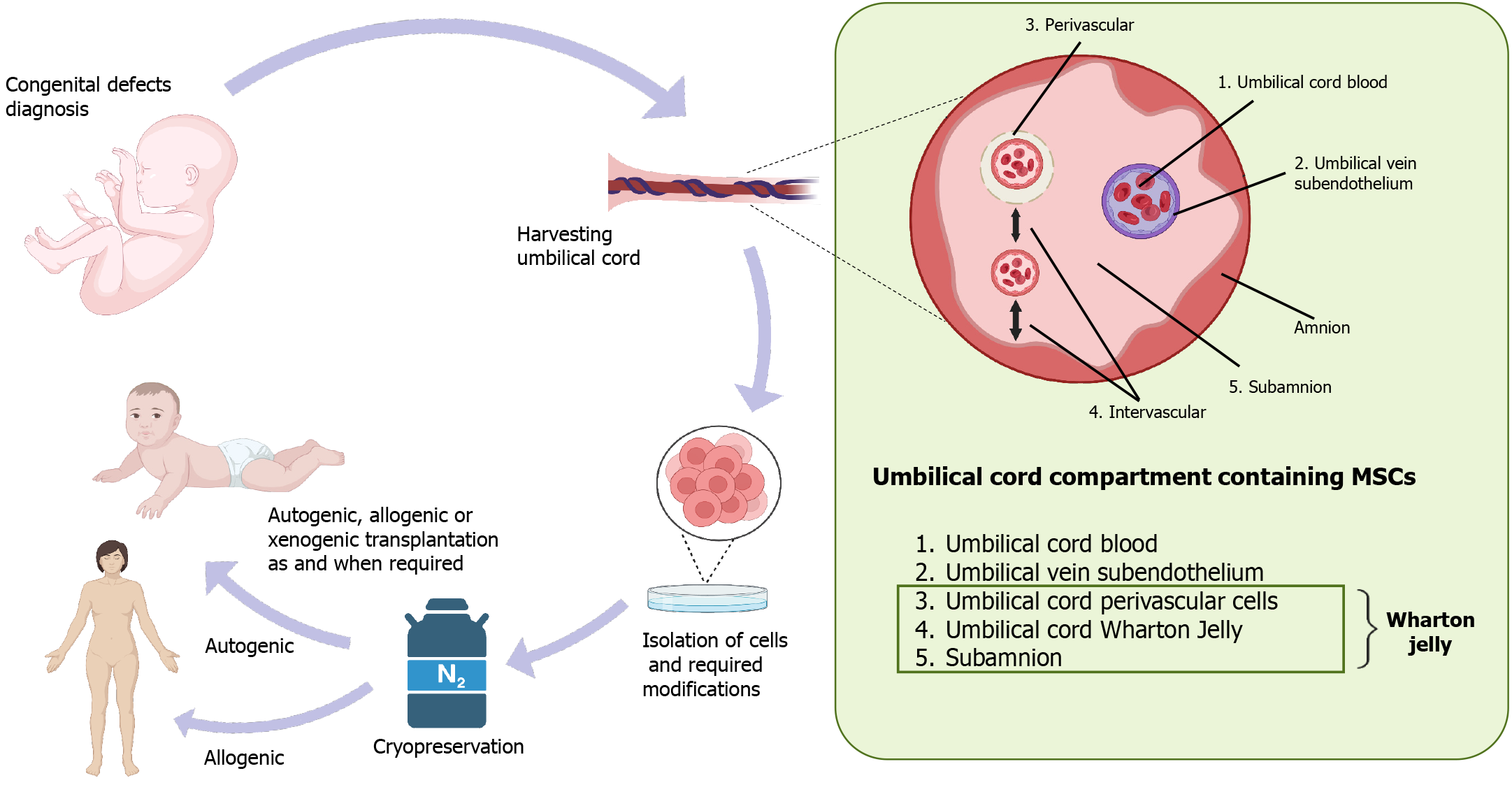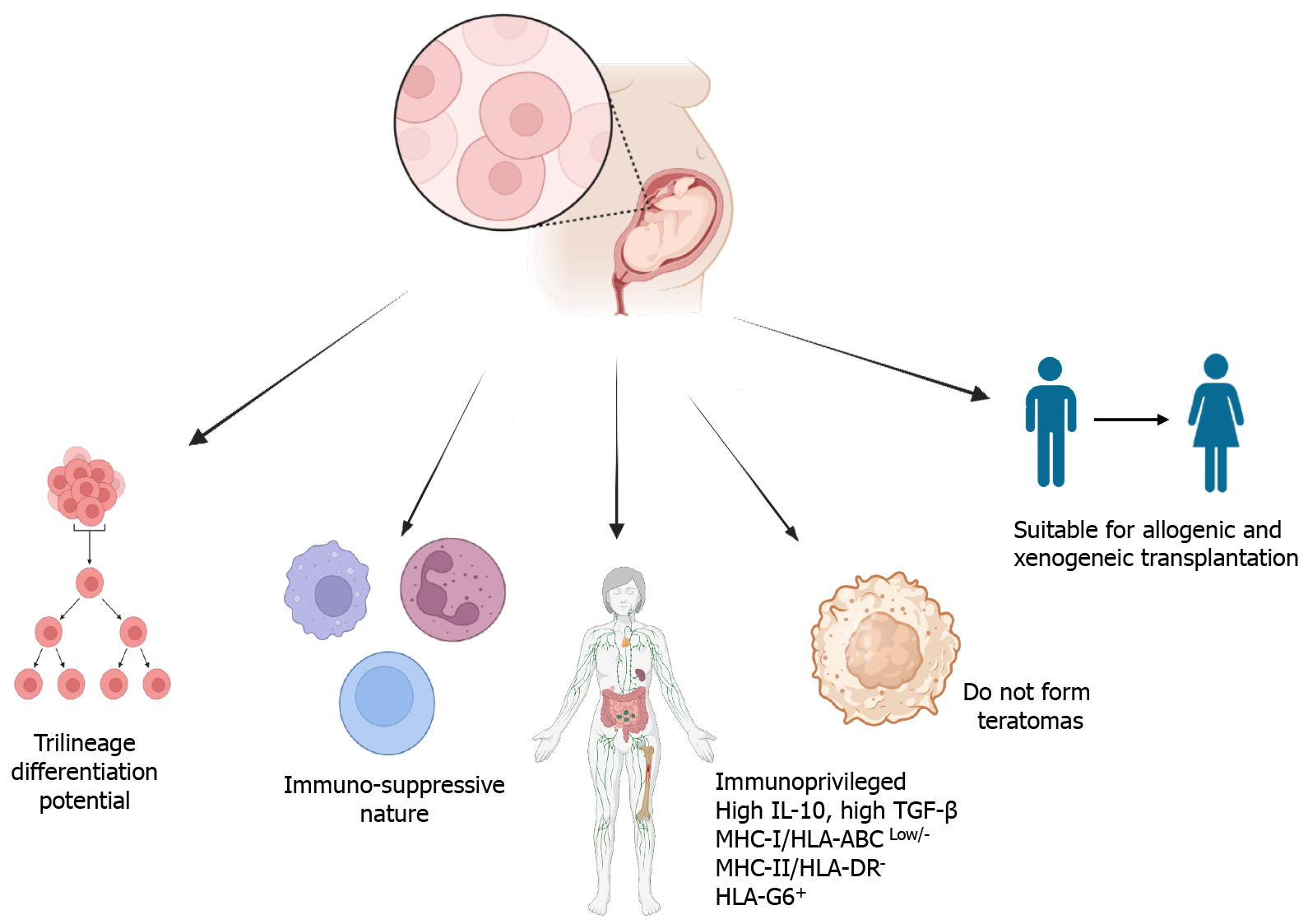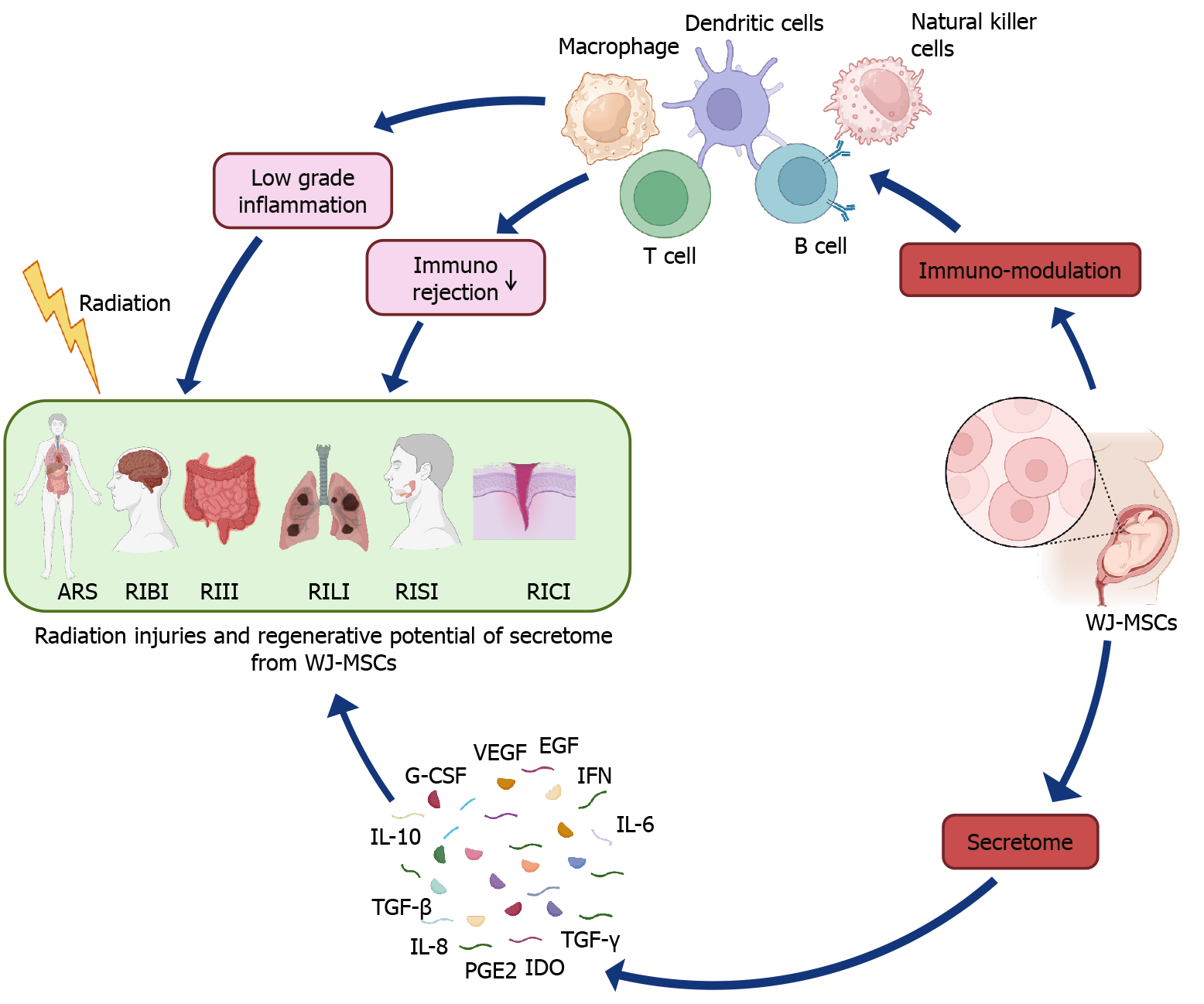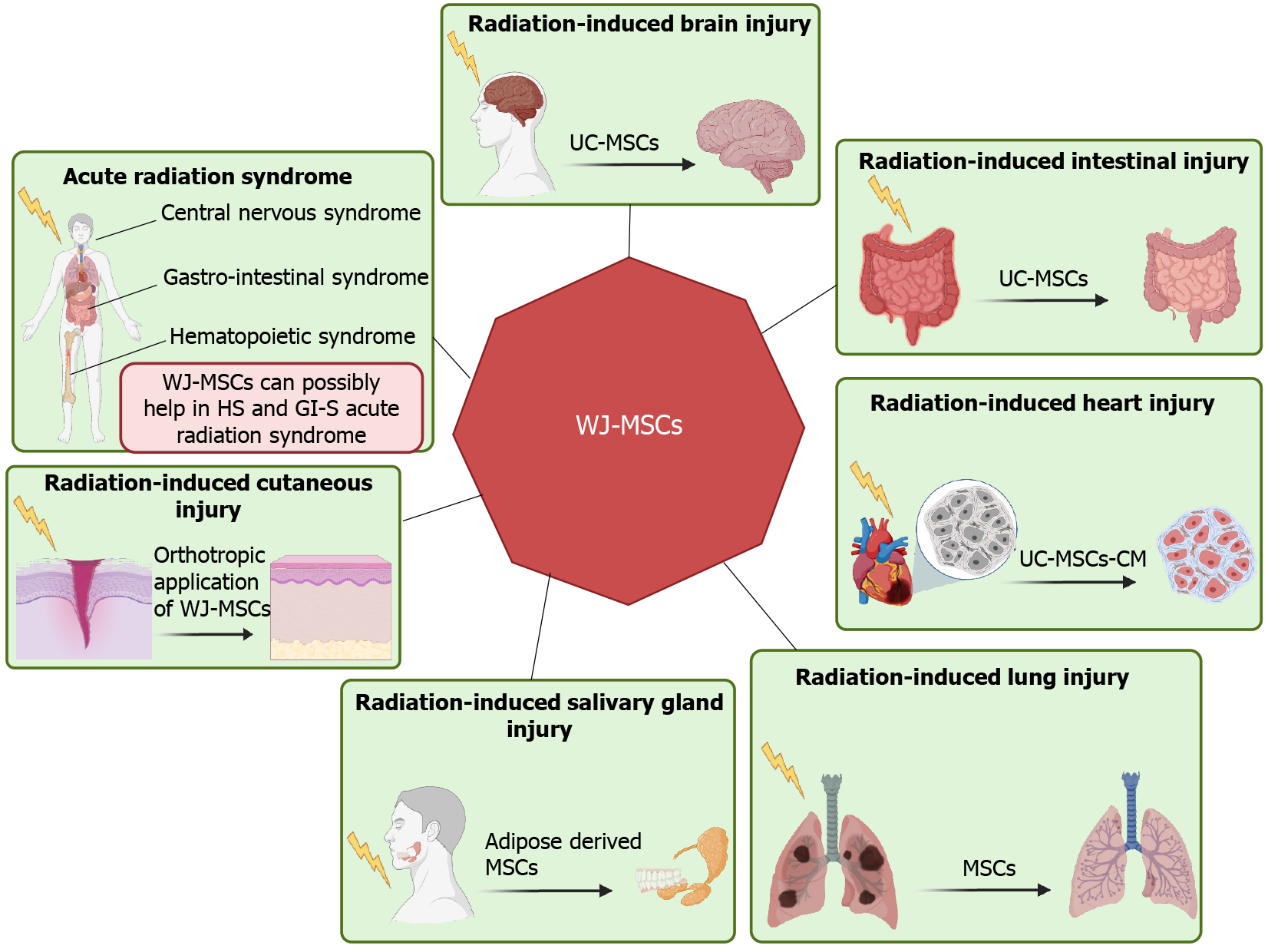Copyright
©The Author(s) 2024.
World J Stem Cells. Jul 26, 2024; 16(7): 742-759
Published online Jul 26, 2024. doi: 10.4252/wjsc.v16.i7.742
Published online Jul 26, 2024. doi: 10.4252/wjsc.v16.i7.742
Figure 1 Illustration of diverse stem cell types with varying differentiation capacities.
Adult stem cells, typically multipotent, differ based on their organ source, e.g., Hematopoietic stem cells in bone marrow and mesenchymal stem cells in various tissues, including Wharton’s jelly from the umbilical cord. In contrast, unipotent cells specialize in specific tissues like muscles, nerves, and more (created with BioRender.com).
Figure 2 Wharton’s jelly mesenchymal stem cells.
Wharton’s jelly contains a large number of multipotent stem cells. The cord’s cross-sectional view reveals five distinct regions rich in mesenchymal stromal cells: (1) Umbilical cord blood; (2) Wharton’s jelly mesenchymal stem cells (MSCs) from umbilical vein subendothelium; (3) Perivascular zone; (4) Intravascular space; and (5) The subamnion region thrives. Zones 3 to 5 belong to Wharton’s jelly. These potent cells, once extracted, can be tailored for various uses, cryopreserved for future needs, or utilized in autogenic, allogenic, or xenogeneic transplants (created with BioRender.com).
Figure 3 Properties of Wharton’s jelly mesenchymal stem cells.
Wharton’s jelly mesenchymal stem cells possess trilineage differentiation potential, making them multipotent. They are immune-suppressive, immunoprivileged, and non-tumorigenic, ideal for allogeneic and xenogeneic transplantation due to their favorable properties (created with BioRender.com). IL: Interleukin; MHC: Major histocompatibility class; TGF: Transforming growth factor.
Figure 4 Illustration of multifaceted role of Wharton’s jelly mesenchymal stem cells in mitigating radiation-induced injuries through direct and indirect immunoregulation.
These cells expertly modulate key immune players: B-cells, macrophages, dendritic cells, and natural killer cells, maintaining controlled inflammation. Wharton’s jelly mesenchymal stem cells (WJ-MSCs) engage in immune regulation via T-cell interactions, displaying HLA class I molecules while lacking costimulatory molecules, thus minimizing rejection risks. In inflamed environments, CD40 and HLA class II molecules may be expressed. WJ-MSCs’ secretome is a potent source of regenerative factors. It contains prostaglandin E2 (PGE2), hepatocyte growth factor (HGF), endothelial growth factor (EGF), vascular endothelial growth factor (VEGF), interleukin (IL)-6, IL-10, transforming growth factor (TGF)-β1, TGF-γ, GCSF, soluble HLA-G5, and soluble galectins (1, 3, and 9). Additionally, WJ-MSCs express indoleamine-2,3-dioxygenase (IDO), driving tryptophan depletion in the medium and generating tryptophan metabolites (kynurenine, 3-hydroxykynurenine, and kynurenic acid). This intricate web of immunomodulation and soluble factors highlights WJ-MSCs’ therapeutic potential in radiation injury recovery (created with BioRender.com). IFN: Interferon; ARS: Acute radiation syndromes; RIBI: Radiation-induced brain injury; RICI: Radiation-induced cutaneous injury; RIII: Radiation-induced intestinal injury; RILI: Radiation-induced lung injury; RISI: Radiation-induced salivary gland injury.
Figure 5 Molecular mechanism of tissue repair and regeneration by Wharton’s jelly mesenchymal stem cells.
Radiation-induced reactive oxygen species (ROS) causes cellular damage. In response to Wharton’s jelly, mesenchymal stem cells (WJ-MSCs) release antioxidant enzymes [superoxide dismutase (SOD), catalase] and transfer healthy mitochondria to damaged cells. Radiation triggers the release of pro-inflammatory cytokines [e.g., tumor necrosis factor-α, interleukin (IL)-1β, interferon (IFN)-γ], causing inflammation and tissue damage. WJ-MSCs migrate to injury sites, guided by chemokine receptors and adhesion molecules. WJ-MSCs interact with T cells through cell-cell contact and soluble factors, inhibiting T-cell proliferation, inducing T-cell apoptosis, and promoting the formation of regulatory T cells. They also secrete factors like prostaglandin E2 (PGE2), hepatocyte growth factor (HGF), IL-6, IL-10, transforming growth factor (TGF) β1, soluble human leukocyte antigen (HLA)-G5, and soluble galectins (1, 3, 9), which help modulate the immune response. Additionally, WJ-MSCs prevent dendritic cell maturation, altering natural killer and B cell functions to reduce inflammation and support tissue repair. Breg: B regulatory cell; CD: Cluster of differentiation; D reg: Dendritic regulatory cell; ICAM: Intercellular adhesion molecule; PD1: Programmed death 1; PDL1: Programmed death-ligand 1; RBC: Red blood cell; TCR: T cell receptor; Th cell: T helper cell; Tregs: T regulatory cells; VCAM: Vascular cell adhesion molecule; VEGF: Vascular endothelial growth factor.
Figure 6 Diagrammatic illustration showing regenerative potential of Wharton’s jelly mesenchymal stem cells in various radiation injuries.
Created with BioRender.com. WJ-MSCs: Wharton’s jelly mesenchymal stem cells; UC-MSC: Umbilical cord mesenchymal stem cell; CM: Conditioned media; HS: Hematopoietic syndrome; GI-S: Gastrointestinal syndrome.
- Citation: Sharma P, Maurya DK. Wharton’s jelly mesenchymal stem cells: Future regenerative medicine for clinical applications in mitigation of radiation injury. World J Stem Cells 2024; 16(7): 742-759
- URL: https://www.wjgnet.com/1948-0210/full/v16/i7/742.htm
- DOI: https://dx.doi.org/10.4252/wjsc.v16.i7.742









